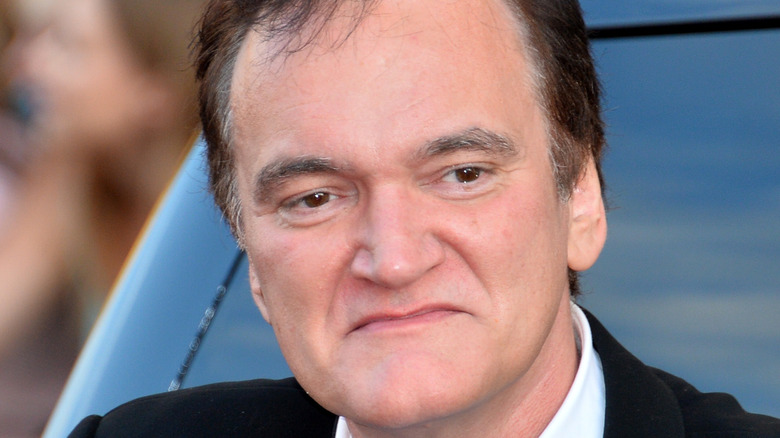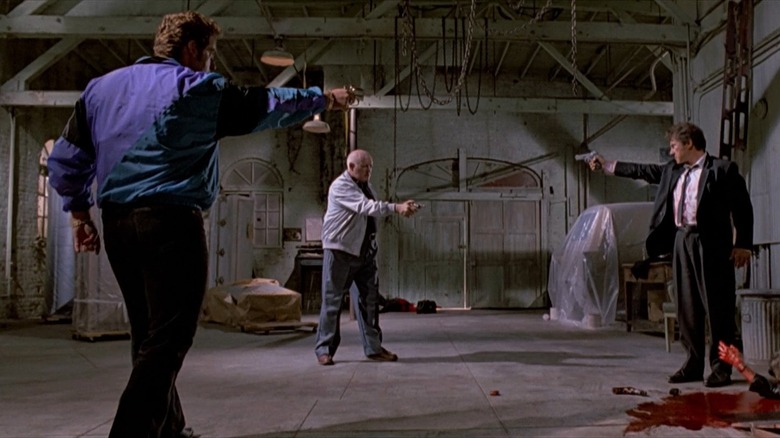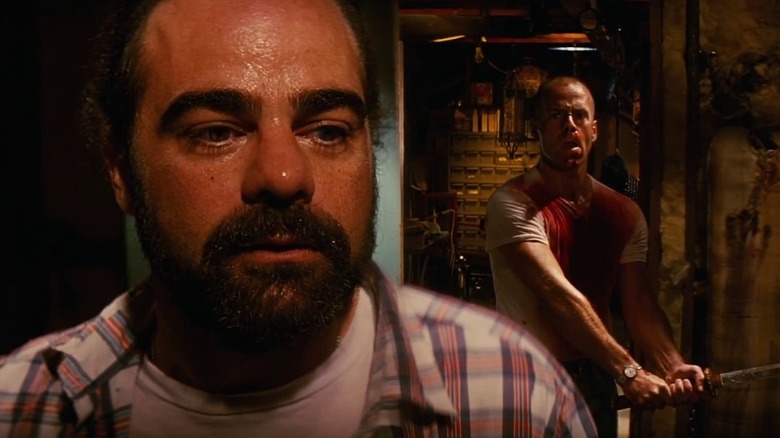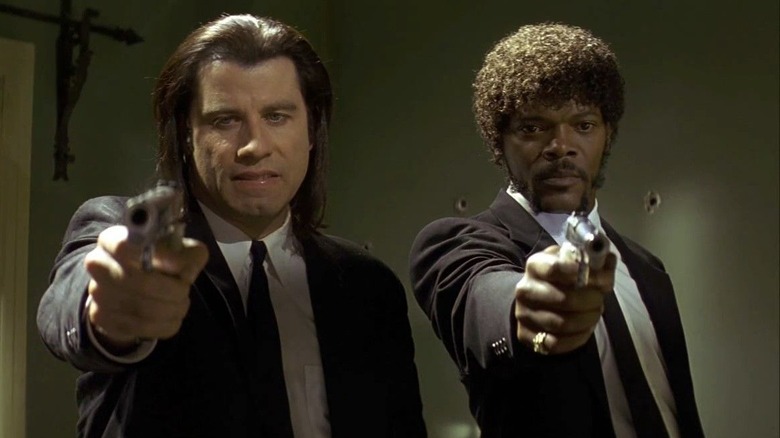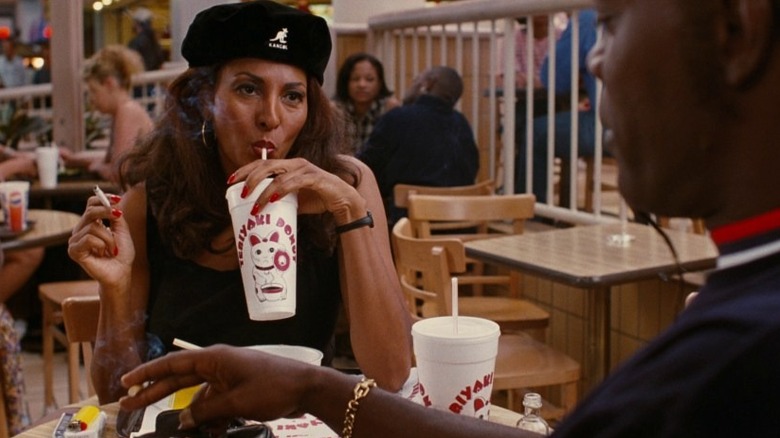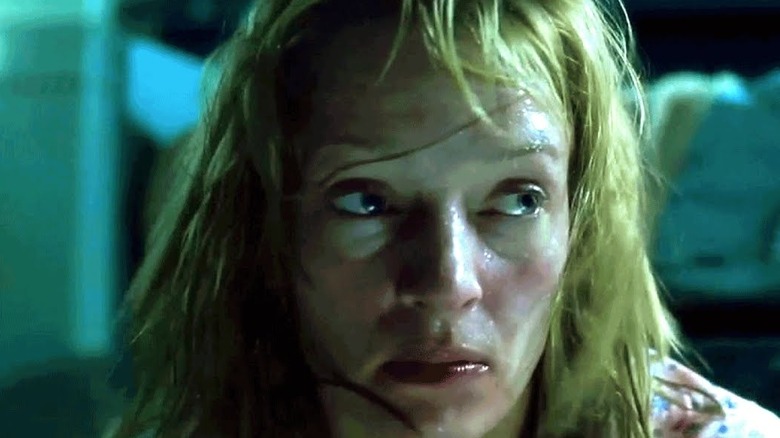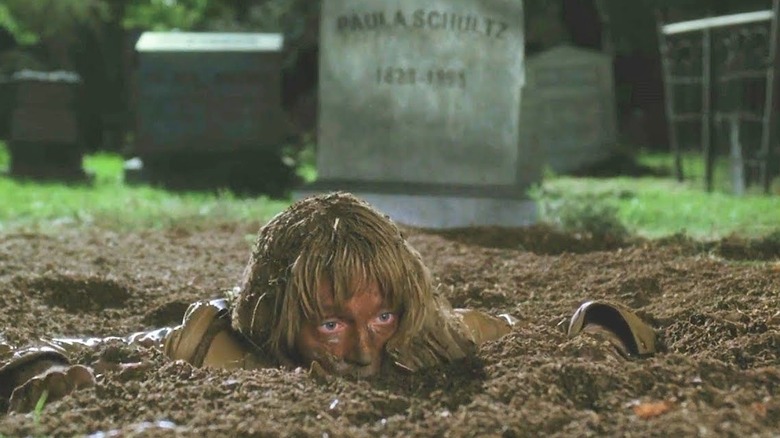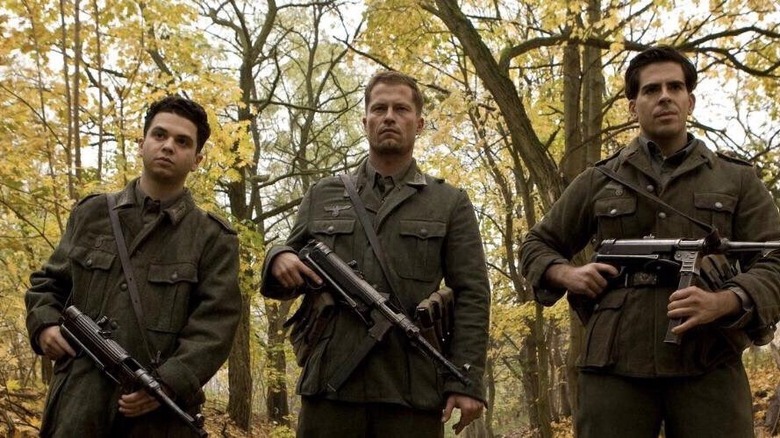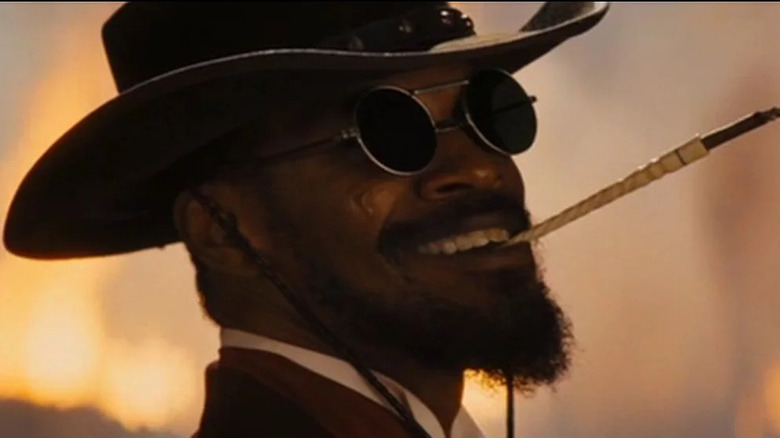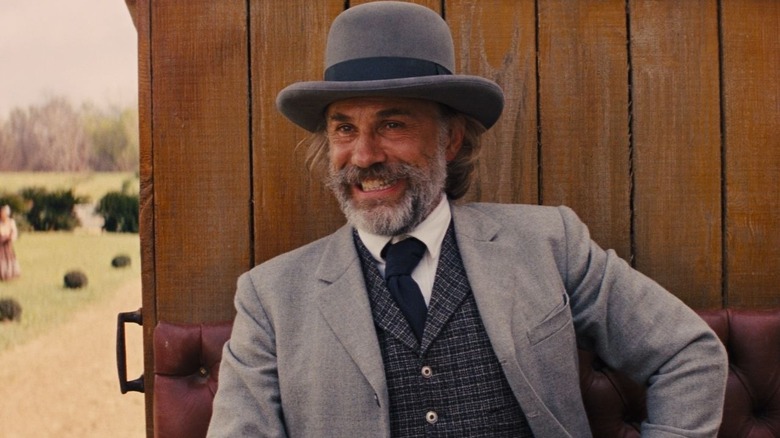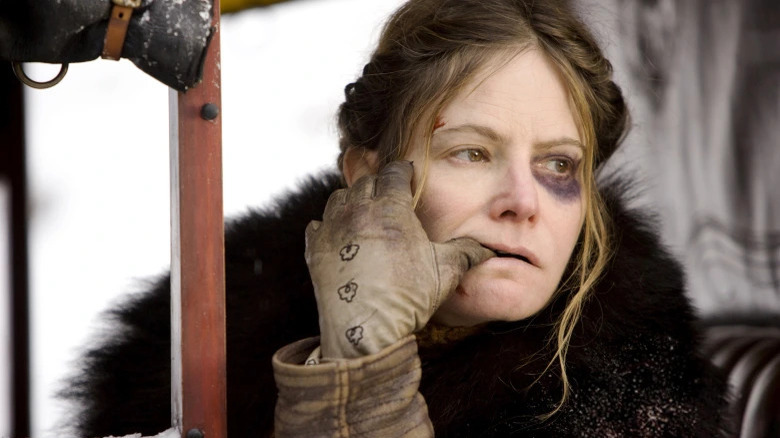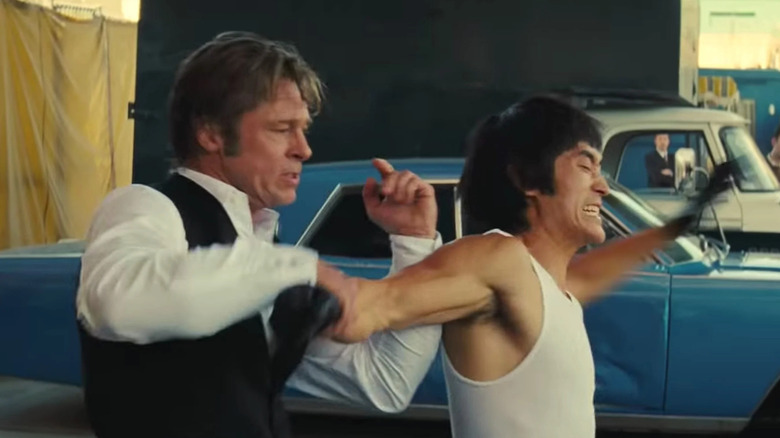Dumb Things In Quentin Tarantino Movies We All Ignore
By and large, Quentin Tarantino movies are critically acclaimed hits (via Metacritic). The director has carved out a style that is referential to the cinema that inspired him, and yet entirely his own. Even his worst movies have defenders, something many filmmakers can't say. The audacious writer and director is one of the most influential currently living American directors (via The Guardian). From 1994's "Pulp Fiction" to 2019's "Once Upon a Time... in Hollywood," Tarantino's vulgar and violent films have engaged audiences worldwide.
But in the wake of success and fame, Tarantino's movies have fallen victim to controversy and critique. Even projects he made back in the '90s when he could seemingly do no wrong contain elements that don't make sense and don't hold up, and that includes "Pulp Fiction" and "Reservoir Dogs." From plot holes to career-long problematic tropes, these are all the dumbest things we ignore in Quentin Tarantino movies, presented in chronological order.
Nice Guy Eddie dies in Reservoir Dogs even though nobody shoots him
A production error led to one of the most baffling moments in "Reservoir Dogs," Tarantino's feature-length directorial debut. In the final shootout at the warehouse that leaves most of the remaining primary characters dead or mortally wounded, Joe (Lawrence Tierney) shoots a bleeding Mr. Orange (Tim Roth) while getting shot by Mr. White (Harvey Keitel). At the same time, Mr. White is shot by Joe's son Nice Guy Eddie (Chris Penn) and falls to the ground along with Joe. Strangely, Eddie also behaves as though he's been shot and collapses accordingly. At one point, the age-old question for "Reservoir Dogs" fans was "Who shot Nice Guy Eddie?"
Eventually, this mystery was answered by the actor himself (via TIME). Penn explained that this continuity error is a result of a production mishap. In the script, White was supposed to fire a second shot that was meant to take Eddie down. However, a blood squib misfired when they shot the scene, forcing Keitel to react and fall down as if he'd been shot. Tarantino decided to roll with the mistake, apparently not predicting just how controversial it would become.
The Gimp in Pulp Fiction is insensitive
Despite its masterpiece status in the eyes of many cinephiles and film students, many elements of "Pulp Fiction" are glaringly out of date. A lot of folks remember how Tarantino inexplicably wrote himself into the movie as a character who constantly hurls racial slurs. But the character of "The Gimp" and the sexual violence that plays out in that storyline stands as a less frequently commented upon but equally problematic part of "Pulp Fiction."
When prizefighter Butch's (Bruce Willis) story intersects with Marsellus Wallace (Ving Rhames), the two are kidnapped, bound, and gagged by the creepy pawnshop owner Maynard (Duane Whitaker). Marsellus is taken into one room and assaulted by Zed (Peter Greene) while the Gimp — a short figure in a bondage suit — watches over Butch in another room. The implicit kink-shaming of the scene makes the derogatory name for this character even worse. Depicting the Gimp as a villain and associating homosexuality with kidnapping and rape seems to reflect some degree of heteronormative bias behind the creation of these characters.
Let's face it — there are almost literally no women in "Reservoir Dogs" and the closest thing to LGBT representation in Tarantino's earlier movies are Maynard, Zed, and the Gimp. "Dogs" and "Pulp" may be all-time classics, but they've got issues.
Pulp Fiction's phantom bullet holes
Despite being often cited as the best Tarantino movie, even "Pulp Fiction" has some holes... literally. Considering the film's popularity, it was only a matter of time before a group of dedicated fans noticed this now-famous continuity error. In the iconic scene where Jules (Samuel L. Jackson) and Vincent Vega (John Travolta) break into Brett's (Frank Whaley) apartment and demand he pay his debt to Marsellus, there is a visible error that disrupts the meticulously crafted world of "Pulp Fiction."
After Jules gives his legendary speech about Big Kahuna burgers and quotes from the Bible, the two gangsters have Marvin (Phil LaMarr) cornered in the apartment. Soon, a stranger emerges from the bathroom and pumps six shots into the wall. The bullets all miss Jules and Vincent, which inspires Jules' reflections on divine intervention later in the story. However, in a previous shot where Jules and Vincent look down at Marvin on the floor, bullet holes are already clearly visible in the wall. It's not a game-breaking bug, but for such a renowned film, it is a silly mistake.
Max should've gotten in Jackie's car
Ok, so don't get us wrong here — the ending of "Jackie Brown" is great. The film is arguably Tarantino's most underappreciated and includes a career-defining performance from Pam Grier as the title character. But even the star agrees that a slight tweak would have given the film a happier, more satisfying ending than bittersweet conclusion we got.
At the end of "Jackie Brown," Max Cherry (Robert Forster) helps ensure Jackie is free and has a new life ahead of her. Planning a trip to Spain, she invites Max to run away with her, but he declines. Looking back on the film after 20 years (via Variety), Grier says she would have done things differently had she been in charge. "In my ending, we have a nice kiss, a second kiss, and embrace." She continues, "He comes with me, gets in the car. I drive off and all of a sudden, he becomes this chatterbox. I go around the block, drop him off and peel out of there."
Kill Bill requires significant suspension of disbelief
It might be an understatement to say "Kill Bill" is a little over the top, and viewing both "Vol.1" and "Vol. 2" requires some suspension of disbelief. The kung fu revenge epic finds its abandoned warrior known as "The Bride" (Uma Thurman), among other names, repeatedly facing and overcoming impossible odds. The world of "Kill Bill" is a heightened version of our world — what things would be like if Tarantino was the director of reality. But one moment in "Kill Bill Vol. 1" is so heinous it would be criminal not to point it out.
After the Bride escapes from the hospital, she takes car keys from her newly dead former assailant Buck (Michael Bowen) and hides in the backseat of his vehicle, which he apparently named the "Pussy Wagon." Paralyzed, the Bride is forced to wait 13 hours in the Pussy Wagon before she can will her legs back into motion. Fans on Reddit argue that by this time, someone would have surely noticed the destruction the Bride caused in the hospital, and they aren't wrong. With two dead bodies, blood trails everywhere, and thousands of dollars in hospital property destroyed, law enforcement would've been looking for the Bride, and probably would have easily found and apprehended her during the time she was struggling to wiggle her big toe in the Pussy Wagon.
The Bride shouldn't have been able to escape being buried alive
It might be one of the most iconic moments in the "Kill Bill" saga, but that doesn't make the Bride's escape from her own grave any less silly. Buried alive, the ex-assassin sometimes called "Beatrix Kiddo" reflects on her training in an extended flashback sequence that leads to her remembering a life-saving move. Using the three-inch punch technique, she shatters her coffin door and breaks free of her tomb. In reality, the Bride would have been crushed and suffocated by the dirt that would come rushing in.
An MTV article from 2005 reports that while the move was inspired by Bruce Lee's one-inch punch, it wouldn't have helped the Bride much in that situation since the weight of the dirt would be a much bigger problem. Most likely, the Bride would die from lack of oxygen before making it to the surface. Premature burial is a horror story trope that dates back all the way back to Edgar Allan Poe at least, but there are not any confirmed cases of anyone surviving being buried alive to this day.
Nobody recognizes Hugo Stiglitz in Inglourious Basterds
This nitpick comes courtesy of Reddit, and we cannot deny it creates quite the conundrum. The final line of "Inglourious Basterds" has Brad Pitt's Nazi-hunting Aldo break the fourth wall, exclaiming, "I think this just might be my masterpiece." While Rotten Tomatoes scores place "Inglourious Basterds" in contention for masterpiece status, this inconsistency might be enough to knock it down a peg.
Early on in the film, one of the Basterds — a Nazi-hunting brigade made of soldiers of all nationalities — Hugo Stiglitz (Til Schweiger) is described as one of the most notorious and feared people in Germany. Flashbacks show that clearly, this is a man whose face is known to many Nazis. Later, he and a few others go undercover at a German bar to gather information, and despite his significant infamy, nobody recognizes him until he gives himself away. Some viewers find this inconsistency totally unbelievable. Still, some fans argue that there were millions of men in the country and the bar was relatively empty, making Hugo's ability to hide in plain sight a little bit of a stretch, but hardly implausible.
Django Unchained shouldn't have dynamite
Another weird oversight from Tarantino's movies is so easy to look up, you have to think at least someone on the film's set had a conversation about it at some point. In the case of the dynamite in "Django Unchained," one small historical inaccuracy makes a world of difference in discerning between reality and fiction.
The bloody and explosive finale of "Django Unchained" is one of Tarantino's best moments, and it is dependent on a scheme Django (Jamie Foxx) hatches to blow up the Candyland mansion. Before the final assault on the manor, Django places dynamite throughout the premises, leading to a literal explosion of catharsis. Here's the problem — the film is set in 1858, but dynamite wasn't invented until 1866 by Alfred Nobel (via McGill University). The abolition of slavery in 1865 means that the numbers on when dynamite was around had to be fudged in order for the story to even make a lick of sense.
King Schultz's scheme is hard to believe
Christoph Waltz as Dr. King Schultz is one of the joys of "Django Unchained" and — like Hans Landa in "Inglourious Bastereds," also played by Waltz — is one of the most colorful characters Tarantino has written. However, there remains some debate among fans whether Schultz's plan — upon which the entire middle section of the film hinges — makes any sense.
In order to rescue Django's wife Broomhilda (Kerry Washington) from plantation and slave owner Calvin Candie (Leonardo DiCaprio), Schultz devises a scheme to rescue her that involves more than just trying to buy her outright. This leads to some deadly consequences, and some argued the "harebrained scheme" made no sense in the first place; Django and Schultz should have just offered Candie the money. One critic (via Huff Post) even got to sit down with Tarantino to discuss why he found this plot point so silly. The director defended his work pretty well, ultimately saying "one of the cool subtexts of the film is that ultimately, yes, they were wrong. If they had approached Candie, he would have sold Broomhilda."
The violence against women in The Hateful Eight is pretty extreme
Tarantino has a long, complex history with inclusion and treatment of female characters in his films (via Polygon). From Madonna being just about the only woman mentioned in "Reservoir Dogs" to the readings of "Kill Bill" as feminist and anti-feminist (via Indiewire) to the Sharon Tate controversy (via Screen Rant) that befell his most recent release, Tarantino's history with women in his films runs the spectrum. It has critics divided in many circumstances, but the filmmaker's darkest and most cynical movie has some pretty rotten misogyny issues. "The Hateful Eight" and its treatment of Daisy Domergue (Jennifer Jason Leigh) was called into question by some critics (via Roger Ebert).
Throughout the movie, Daisy is beaten to a bloody pulp and hung up like a corpse. She is a passive character who acts as a punching bag for many of the men. "The Hateful Eight" lacks any moments of empowerment or flashbacks to Daisy in her prime to make up for this constant abuse. Unlike Tarantino's best characters, she doesn't have the depth of "Beatrix Kiddo," nor can she claim the fierce edge of the women from "Death Proof." It seems Tarantino designed Daisy as a weak woman who ultimately gets killed, which feels like a real waste of a Jennifer Jason Leigh performance.
Once Upon a Time... In Hollywood is pretty disrespectful to Bruce Lee
When Tarantino's latest epic, "Once Upon a Time... In Hollywood," was released in 2019, it was unsurprisingly met with critical acclaim and multiple controversies. Among them were discussions of the inclusion and characterization of real-world Manson Family victim Sharon Tate (Margot Robbie). That discourse is worthy of attention, though there's some nuance to that conversation. Another controversy is a pretty textbook dumb Tarantino move. Of all the director's callbacks to old Hollywood in "Once Upon A Time..." the portrayal of Bruce Lee tops the list as the strangest and silliest. It also ends up being pretty disrespectful.
In a scene that is part fantasy and part in-movie reality, Cliff Booth (Brad Pitt) faces off against a cocky, macho Bruce Lee (Mike Moh) and wins one of two brawls with the actor. Shannon Lee, Bruce's granddaughter, objected to the portrayal of the martial arts legend (via Vox), saying "they didn't need to treat him in the way that white Hollywood did when he was alive."
